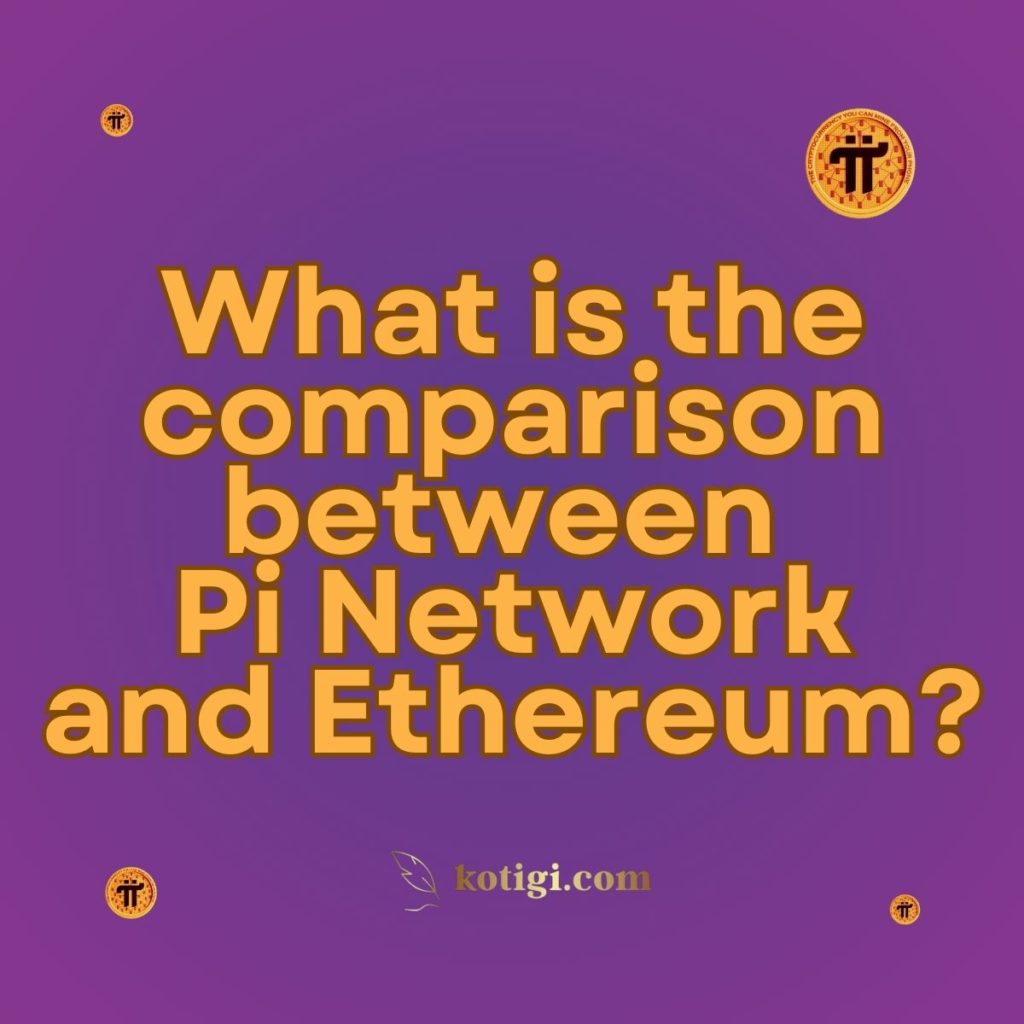
What is the comparison between Pi Network and Ethereum?
Pi Network and Ethereum serve different purposes within the cryptocurrency landscape. While Ethereum is a leading platform for decentralized applications (dApps) and smart contracts, Pi Network aims to create an accessible cryptocurrency that empowers users through mobile mining and community engagement. This article explores the key differences and similarities between Pi and Ethereum, highlighting their respective roles in the evolving digital economy.
Introduction
As the cryptocurrency ecosystem continues to expand, various projects are emerging with unique goals and functionalities. Among these projects, Ethereum stands out as a pioneering platform that introduced the concept of smart contracts and decentralized applications (dApps). Its robust blockchain has become the foundation for numerous projects, enabling developers to create and deploy innovative solutions. In contrast, Pi Network represents a more recent initiative that focuses on making cryptocurrency accessible to a broader audience through mobile mining and community-driven efforts. This article delves into the key aspects of both Pi Network and Ethereum, examining their technological foundations, use cases, community engagement, economic models, and regulatory considerations. By comparing these two cryptocurrencies, we can better understand their respective contributions to the digital economy.
Comparison Table of Pi Network vs Ethereum
Here’s a comparison table highlighting the key differences and similarities between Pi Network and Ethereum:
| Feature | Pi Network | Ethereum |
|---|---|---|
| Launch Year | 2019 | 2015 |
| Founder(s) | Nicolas Kokkalis, Chengdiao Fan, Vincent McPhillip | Vitalik Buterin and others |
| Consensus Mechanism | Stellar Consensus Protocol (SCP) | Proof of Stake (PoS) (transitioning from Proof of Work) |
| Mining Method | Mobile mining accessible to all users | Requires specialized hardware and energy consumption for PoW; validators stake coins for PoS |
| Total Supply | Not capped; community-driven distribution | No maximum supply limit |
| Transaction Speed | Faster transaction speeds due to mobile-first design | Approximately 30 transactions per second (TPS) |
| Main Use Case | Peer-to-peer transactions, community-driven applications | Smart contracts, decentralized applications (dApps), financial services |
| Accessibility | Highly accessible via mobile app | Requires technical knowledge and infrastructure |
| Community Engagement | Strong focus on user participation and referrals | Community-driven but investment-focused |
| Market Capitalization | Still developing; not yet established | One of the highest market capitalizations among cryptocurrencies |
| Regulatory Status | Aims for compliance and transparency | Varies by jurisdiction; some regulatory scrutiny |
| Environmental Impact | Minimal impact due to low energy consumption | High due to energy-intensive mining process (in PoW) |
| Future Potential | Focused on creating practical utility and adoption | Established as a leading digital asset with institutional interest |
Technology and Architecture
The technological architecture of a cryptocurrency plays a crucial role in determining its functionality, scalability, and security. Both Pi Network and Ethereum have distinct approaches to blockchain technology, influencing their usability and overall ecosystem.
Blockchain Technology
Ethereum operates on a decentralized blockchain that supports smart contracts—self-executing contracts with the terms of the agreement directly written into code. This feature allows developers to create dApps that run on the Ethereum blockchain, enabling a wide range of use cases, from finance to gaming.
In contrast, Pi Network employs a unique consensus mechanism known as the Stellar Consensus Protocol (SCP). This protocol allows users to mine Pi coins through a mobile app, making the process more accessible compared to Ethereum’s traditional mining methods. While Pi Network does not currently support smart contracts, its focus on mobile accessibility sets it apart from Ethereum.
Consensus Mechanism
Ethereum initially utilized a Proof of Work (PoW) consensus mechanism, which required significant computational power and energy consumption. However, Ethereum is transitioning to Proof of Stake (PoS) with the Ethereum 2.0 upgrade, which aims to improve scalability and energy efficiency by allowing validators to create new blocks based on the number of coins they hold and are willing to “stake.”
Pi Network’s SCP allows transactions to be validated by a network of trusted nodes without the need for energy-intensive mining. This approach significantly reduces the environmental impact and increases accessibility, but it raises questions about decentralization and security compared to Ethereum’s more established model.
Scalability Solutions
Scalability has been a pressing concern for Ethereum, especially during periods of high demand. The network can process approximately 30 transactions per second (TPS), which can lead to congestion and increased fees. Ethereum’s upcoming upgrades aim to address these scalability issues and enhance its performance.
Pi Network’s design allows it to handle a larger volume of transactions due to its mobile-first approach. However, as the network develops, its scalability will be tested against real-world usage, and the effectiveness of its model will become clearer.
Accessibility and Usability
The accessibility and usability of a cryptocurrency significantly impact user engagement and adoption. Pi Network and Ethereum have different approaches to ensuring that users can effectively participate in their ecosystems.
Mobile Mining vs. Development Environment
Pi Network’s mobile mining capability allows users to earn Pi coins effortlessly through a user-friendly app. This accessibility encourages individuals with little to no technical knowledge to participate in cryptocurrency mining and contribute to the network’s growth.
In contrast, Ethereum requires users to have a deeper understanding of blockchain technology to engage with its ecosystem effectively. Developers must learn Solidity, Ethereum’s programming language, to create smart contracts and dApps. While Ethereum’s environment is robust and versatile, it may pose a barrier to entry for those unfamiliar with coding and blockchain principles.
User Experience
Pi Network places a strong emphasis on user experience, providing a simple interface that allows users to mine coins, engage with the community, and access educational resources. This design philosophy promotes active participation and encourages new users to explore cryptocurrency.
Ethereum, while functional, can be more complex to navigate, particularly for those unfamiliar with decentralized finance (DeFi) applications and smart contracts. Users must navigate wallets, transaction fees, and contract interactions, which may deter some potential participants.
Community Engagement
Both Pi Network and Ethereum benefit from strong community engagement, albeit in different ways. Pi Network incentivizes user participation through rewards and referral programs, fostering a sense of community and ownership among users.
Ethereum also boasts a dedicated community of developers, investors, and enthusiasts. However, its growth has often been driven by speculation and investment rather than grassroots engagement. The emphasis on user participation in Pi Network sets it apart as a more inclusive platform for newcomers.
Use Cases and Applications
The practical applications of a cryptocurrency play a vital role in its adoption and utility. Pi Network and Ethereum serve different purposes, catering to various audiences and use cases.
Smart Contracts and dApps
Ethereum is the leading platform for decentralized applications and smart contracts, allowing developers to create a wide range of solutions across various industries, including finance, gaming, and supply chain management. The versatility of Ethereum’s blockchain has fostered innovation and led to the rise of DeFi, non-fungible tokens (NFTs), and more.
Pi Network, while not currently supporting smart contracts, aims to facilitate peer-to-peer transactions and community-driven applications. Its focus is on creating a user-friendly ecosystem that empowers individuals to engage in cryptocurrency without the technical barriers typically associated with blockchain technology.
Peer-to-Peer Transactions
Both Pi Network and Ethereum enable peer-to-peer transactions, but they do so in different ways. Ethereum’s platform allows for various financial applications and services, making it suitable for users looking to engage in DeFi or trade tokens.
Pi Network focuses on making cryptocurrency accessible for everyday transactions. By facilitating peer-to-peer exchanges within its community, Pi aims to establish itself as a practical medium of exchange rather than a speculative asset.
Future Innovations
Ethereum’s commitment to innovation has led to numerous advancements, including the development of Layer 2 scaling solutions and various interoperability projects. These innovations enhance Ethereum’s capabilities and further solidify its position as a leading blockchain platform.
Pi Network is still in the early stages of development but has the potential to create innovative solutions tailored to its user base. As the network matures, the introduction of dApps and partnerships may enhance its utility and expand its ecosystem.
Economic Models and Tokenomics
The economic models and tokenomics of a cryptocurrency are crucial in shaping its value and user engagement. Both Pi Network and Ethereum have distinct approaches to distribution, supply, and inflation rates.
Supply and Distribution
Ethereum has no maximum supply limit, with new coins being issued as rewards for validators in the PoS mechanism. This inflationary model is designed to incentivize network participation and secure the blockchain. Ethereum’s issuance rate decreases over time, which can create deflationary pressures.
Pi Network operates with a different distribution model, where users earn coins through mobile mining and community engagement. The total supply of Pi coins is not predetermined, and the project emphasizes user-driven distribution to encourage broader participation in the ecosystem.
Inflation and Deflation
The inflationary nature of Ethereum allows for continuous rewards for validators, but it also raises concerns about the long-term value of ETH as new coins are created. This model aims to balance incentives for network security while maintaining a healthy economy.
Pi Network’s approach to inflation is designed to promote user participation and growth. While the lack of a capped supply may raise questions about inflation, the emphasis on real-world utility and community engagement seeks to mitigate these concerns.
Market Capitalization
Ethereum consistently ranks among the top cryptocurrencies by market capitalization, reflecting its established status and widespread adoption. Institutional interest in Ethereum has increased, further solidifying its position in the digital asset landscape.
Pi Network is still in the developmental phase, and its market capitalization remains to be established. The success of Pi’s market performance will depend on user engagement, partnerships, and the overall growth of its ecosystem.
Regulatory Considerations
As the cryptocurrency landscape matures, regulatory scrutiny is increasing. Understanding the regulatory environment is essential for both Pi Network and Ethereum, as it impacts their adoption and long-term viability.
Compliance and Regulations
Ethereum has faced regulatory challenges in various jurisdictions, particularly concerning the classification of tokens and DeFi projects. As governments develop clearer frameworks for cryptocurrencies, Ethereum’s adaptability will be critical to its continued growth and acceptance.
Pi Network aims to operate within regulatory frameworks to build trust with users and authorities. By prioritizing compliance and transparency, Pi seeks to position itself as a legitimate player in the cryptocurrency market.
User Safety
Regulatory considerations also influence user safety and protection. Ethereum’s decentralized nature can complicate seeking recourse for users in cases of fraud or loss. Conversely, Pi Network’s community-driven approach may enhance user safety by fostering a supportive environment for sharing experiences and knowledge.
Future Implications
The evolving regulatory landscape will significantly impact both Pi Network and Ethereum. Projects that prioritize compliance and transparency are more likely to thrive in the long run. The ability of both networks to navigate these challenges will play a critical role in their future viability.
Conclusion
The comparison between Pi Network and Ethereum highlights two distinct approaches to cryptocurrency, each with unique strengths and challenges. Ethereum, as a leading platform for smart contracts and decentralized applications, boasts a robust ecosystem that supports innovation and growth across various industries. However, its complexity and accessibility issues can deter some users.
In contrast, Pi Network focuses on democratizing cryptocurrency through mobile mining and community engagement. Its user-friendly approach and emphasis on practical utility position it as a potential player in the digital economy, but its long-term success will depend on user participation, market adoption, and the evolution of its tokenomics.
As the cryptocurrency landscape continues to evolve, understanding the differences and similarities between Pi and Ethereum is essential for users and investors alike. Both cryptocurrencies contribute to the ongoing transformation of the financial system, representing different paths toward achieving their goals.
Key Takeaways
- Technology and Architecture: Ethereum utilizes a decentralized blockchain for smart contracts, while Pi Network employs a unique consensus mechanism that allows mobile mining.
- Accessibility and Usability: Pi Network emphasizes user-friendly mobile mining, making it more accessible, while Ethereum’s complexity may pose challenges for new users.
- Use Cases and Applications: Ethereum supports a wide range of dApps and financial applications, whereas Pi Network aims to facilitate everyday transactions within its community.
- Economic Models and Tokenomics: Ethereum has an inflationary supply model, while Pi Network focuses on community-driven distribution without a predetermined supply cap.
- Regulatory Considerations: Both Pi Network and Ethereum face regulatory challenges, with a focus on compliance being crucial for their long-term viability.





